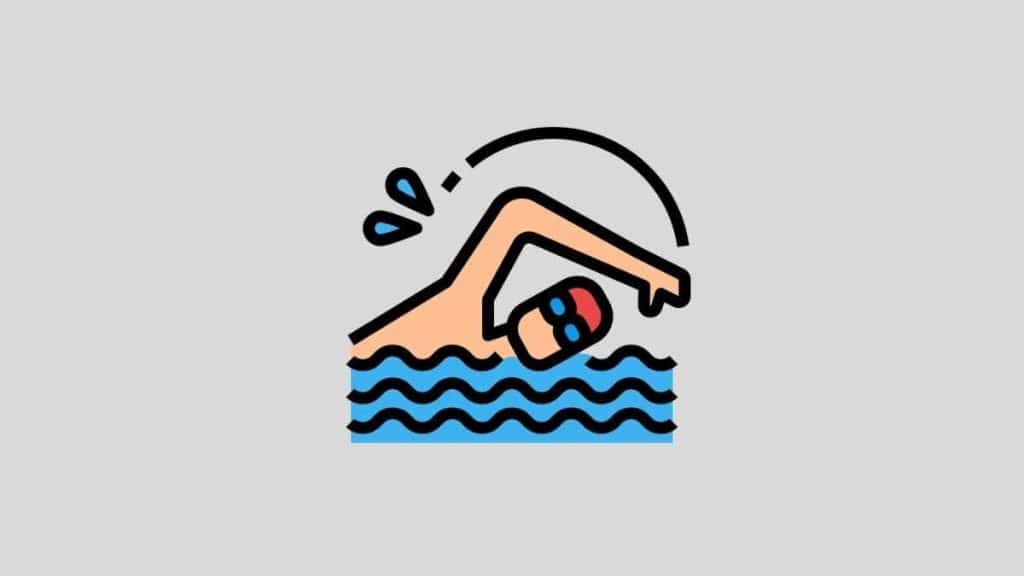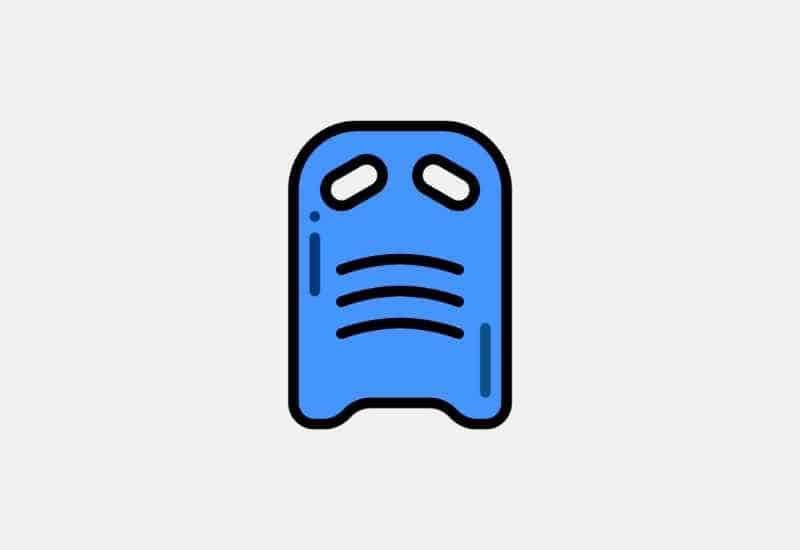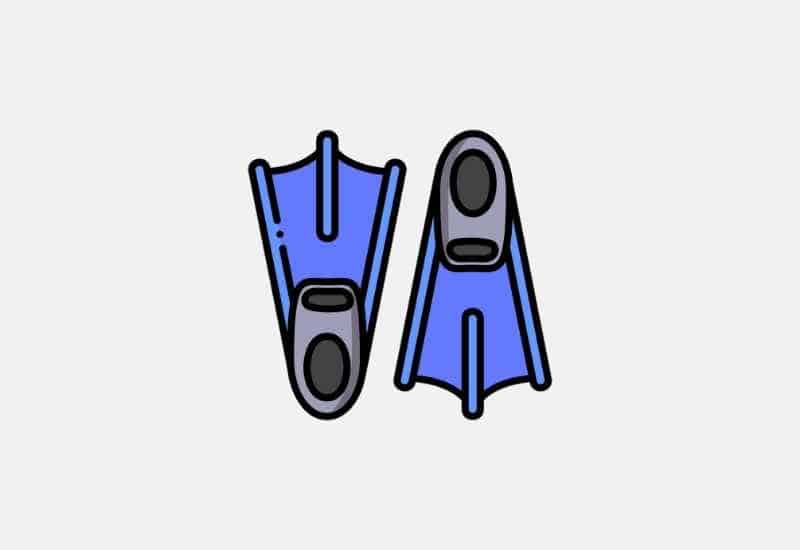Hit the water with confidence with these swim workouts designed specifically for beginners. Plus, the key things every one of your swim workouts should include.

Jumping into a chlorinated pool of water is one of the best ways you can lose weight, build muscle, and even improve your mental health.
But while swimming looks easy—Michael Phelps made it look so easy, after all, with his smooth and splash-free strokes—it can quickly get overwhelming.
Mastering swimming technique is surprisingly hard. And the constant feeling of being out-of-breath can discourage a lot of beginners.
In this round-up of the best swim workouts for beginner swimmers, we’ll look at some simple templates you can take with you to the pool.
While I can’t promise you that the workouts will turn you into a Katie Ledecky or a Michael Phelps, you will get a great workout.
Let’s dive right in.
Swim Workout #1 – The Basics
The template for this workout is simple and focuses on shorter bursts of swimming with adequate rest to keep your technique in the good books.
200m warm up, choice of strokes. Provided you have done a decent dynamic warm-up prior to getting in the water (check out this article on the best stretches for swimmers for some excellent suggestions on pre-workout stretches), these first few laps are just about getting your feel for the water.
10x50m freestyle. These can be done at a moderately to strong pace. Don’t be afraid of pushing the pace. Take around :20 to :30 rest between reps. As you get in better shape, increase the number of reps you do, building up to 20-30 repetitions.
100 warm down, choice of strokes. Backstroke is always a great stroke to use when warming down as it will really help to open up those tight shoulders and chest muscles after a big main set.
Total distance: 800m
Swim Workout #2 — Increased HR and Lower Body Focus
Let’s ramp up the heart rate by introducing kicking into the mix.
200m warm-up, choice of strokes.
4x50m kick using a kickboard. Take :30 rest between reps.

8x100m as 50m kick, 50m swim. Take :30 rest between reps. This set will get your heart rate GOING. Kicking in the water is a challenge for most new swimmers and because the legs have the biggest muscles in the body, the metabolic demand is huge. You find your heart rate will soar when pairing kick with swim.
100m warm-down, choice of strokes. Catch your breath and kickstart the recovery process with some light and easy strokes to finish things off.
Total distance: 1,300m
Swim Workout #3 – Getting Your Pull On
200m swim choice. Get nice and loose and ready for some upper body action!
4x25m “windshield wiper” sculling (:20 rest between laps). Sculling is an excellent tool for improving your hand’s ability to “catch” water. The rapid back and forth of sculling is also great training for the stabilizer muscles in the elbows and shoulders.
4x50m freestyle with a pull-buoy (descend effort 1-4). Take :20 rest between reps
8x75m freestyle with a pull buoy (desc effort 1-4, 5-8). Take :20 rest between reps
100m swim easy. Shake it out and shake it off.
Total distance: 1,200m
Swim Workout #4 – Skills and Drills
This workout is all about intention and a focus on swimming with awesome body position in the water. Good position in the water results in less drag, which translates quickly into significantly more speed.
200m swim choice.
4x100m kick with fins. Focus on keeping your hips nice and high. :20 rest between reps.
100m swim recovery. Reset and recover.
8x50m swim with fins. Swim with 75% effort. Carry on that focus with keeping high hips. :30 rest between reps.

100m swim recovery. Reset and recover.
8×25 freestyle drill. Take :20 rest between reps. Choose a freestyle drill that matches what you are trying to improve with your swim technique. Single arm drill, long dog drill, closed fist freestyle, etc.
100m swim easy warm-down.
Total distance: 1,500m
Workout #5 – Speed and Power
With this swim workout, we are going to dust off some of the toys and gear that live in your mesh bag or the equipment bin at the local pool and crank up the speed and power.
200m warm-up, choice of strokes.
8x100m swim. Descend the effort 1-4 and 5-8, with #4 and #8 swimming at 95% effort. Take :30 rest between reps.
100m recovery to reset.
6x25m swim with fins ALL OUT. Take :90 to 2:00 rest between reps. The goal is all-out speed and power, so don’t worry about taking a little extra rest between those all-out efforts. Using fins is a great way to teach your body more efficient body position while also cranking up the metabolic demand on your legs.
100m swim warm-down.
Total distance: 1,350m
Common Questions About Beginner Swim Workouts
How do I know I am getting a good workout when swimming?
Oh, you will know!
Swimming has the distinct advantage of forcing you to breathe less when churning up and down the pool, which places you into immediate pulmonary duress.
In other words, you will be out of breath quicker, your heart rate will elevate, and those calories will light themselves on fire.
Of course, you can always use a smartwatch that has a heart rate monitor inside, or the old school two-fingers-on-the-neck to measure your heart rate at the pool.
How many laps is a good swim workout?
This depends on a few different factors, but the primary thing to look at is the time elapsed in your target heart rate zones. Aim for 30-40 minutes with your heart rate in the aerobic zone.
How many laps this will take for you to accomplish this goal depends on the speed and pace you are holding in the water.
While I can understand the focus on completing a specific number of laps to measure the efficacy of your workout, it’s simpler to focus on the amount of time you spend swimming laps.
The reality is that you will become more efficient and faster in the pool, so measuring only laps won’t give you an accurate assessment of how good the workout was.
What equipment do beginner swimmers need?
A set of swim goggles and a swimsuit is all you really need to get started with swim workouts.
If you want to target your lower body, consider introducing a kickboard and/or swim fins. To really target your shoulders, consider investing in a pull buoy, and as you get more experienced, a quality set of swim paddles.
Ultimately, getting a good workout is less about the tools and more about the effort, but the tools do have a role to play when it comes to mixing things up, switching the focus of the workout, and even improving swimming technique.
What should a beginner swim workout include?
Each workout, whether you are a beginner or have Olympic aspirations, should include:
⭐ Dynamic stretches before you get in the water.
There are a lot of benefits of dynamic stretching, including elevated heart rate, increased blood flow to target areas, and they open up your range of motion so that you can perform the strokes properly.
See also: 5 Best Upper Body Dynamic Stretches for Better Workouts
Arm swings and leg swings are my go-to dynamic stretches and are an essential add-on to your swim workouts.
They will reduce the likelihood of injury and because of the elevated heart rate, you will be hitting the (chilly) water ready for action.
⭐ Warm-up.
Once in the water, a pool-specfic warm-up is recommended to increase your feel for the water. This is part of setting you up for an excellent main set.
As you get more experienced, feel free to add activation sets to your warm-ups, but this is not necessary when starting out. Warm-up is a great place to include kick and drill work, as they will increase your heart rate quickly and dial in your technique, respectively.
⭐ Main set.
The meat and potatoes of your workout! This is where we push the pace, burn the calories, and kick all of the butts.
Aim to try and get 30+ minutes in an aerobic heart rate zone.
⭐ Warm-down.
A short and sweet warm-down will help bring down your heart rate, transition you out of the workout, adn promote blood flow to all the muscles you just worked, helping to kick off a faster recovery.
The Bottom Line
Swimming is my favorite form of cardiovascular exercise, and not just because it’s a monster for burning calories and improving lung strength.
Getting in the pool also forces us to unplug from our smartphones and screens for a while, giving our brains a nice rest.
Additionally, there is so much variety with designing swim workouts for yourself.
You can target the upper body with pulling sets, the legs with kicking sets, and go full-body mode with regular swimming.
The next time you hit the pool, take these workouts with you, adjust them as necessary, and reap the benefits of smelling like chlorine for the rest of the day.
More Swim Guides and Resources
3 Swim Workouts for Building Muscle (and How to Avoid Losing Muscle Mass). Can swimming build muscle? Yes—when done properly. Here are the best practices for building muscle in the pool and three swim workouts to get you started.